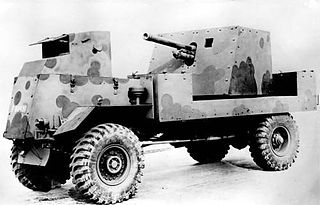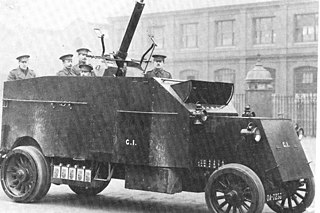
An armoured fighting vehicle or armored fighting vehicle (AFV) is an armed combat vehicle protected by armour, generally combining operational mobility with offensive and defensive capabilities. AFVs can be wheeled or tracked. Examples of AFVs are tanks, armoured cars, assault guns, self-propelled artilleries, infantry fighting vehicles (IFV), and armoured personnel carriers (APC).

A tank destroyer, tank hunter or tank killer is a type of armoured fighting vehicle, predominantly intended for anti-tank duties. They are typically armed with a direct fire artillery gun, also known as a self-propelled anti-tank gun, or missile launcher, also called an anti-tank missile carrier. The vehicles are designed specifically to engage and destroy enemy tanks, often with limited operational capacities.

An anti-aircraft vehicle, also known as a self-propelled anti-aircraft gun (SPAAG) or self-propelled air defense system (SPAD), is a mobile vehicle with a dedicated anti-aircraft capability.

Self-propelled artillery is artillery equipped with its own propulsion system to move toward its firing position. Within the terminology are the self-propelled gun, self-propelled howitzer, self-propelled mortar, and self-propelled rocket artillery. They are high mobility vehicles, usually based on continuous tracks carrying either a large field gun, howitzer, mortar, or some form of rocket/missile launcher. They are usually used for long-range indirect bombardment support on the battlefield.

The 25pdr SP, tracked, Sexton was a Canadian-designed self-propelled artillery vehicle of the Second World War. It was based on Canadian-built derivatives of the American M3 Lee and M4 Sherman tank chassis. Canada had set up to produce the Ram tank using the M3 chassis and Grizzly to complement US medium tank production; when Sherman production in the US expanded and supply was no longer a problem, it was decided in 1943 to switch the Canadian production lines to produce the Sexton to give the British Army a mobile artillery gun using their 87.6 mm (3.45 in) Ordnance QF 25-pounder gun-howitzer for commonality with towed guns. The Sexton could fire either HE shell or an armour-piercing shell. It found use in the Canadian, British, and other British Commonwealth armies, as well as other countries. After the war, a number of Sextons and Grizzlies were sold to Portugal, which used them into the 1980s.

The Self Propelled 17pdr, Valentine, Mk I, Archer was a British tank destroyer of the Second World War based on the Valentine infantry tank chassis fitted with an Ordnance QF 17 pounder gun. Designed and manufactured by Vickers-Armstrongs, 655 were produced between March 1943 and May 1945. It was used in north-west Europe and Italy during the war; post-war, it served with the Egyptian Army. This vehicle was unusual in that its gun faced the rear of the chassis instead of the front.

AEC Armoured Car is the name of a series of British heavy armoured cars built by the Associated Equipment Company (AEC) during the Second World War.

The Tank, Cruiser, Ram was a cruiser tank designed and built by Canada in the Second World War, based on the U.S. M3 Medium tank chassis. Due to standardization on the American Sherman tank for frontline units, it was used exclusively for training purposes and was never used in combat as a gun tank. The chassis was used for several other combat roles however, such as a flamethrower tank, observation post and armoured personnel carrier.

The Gun Carrier Mark I was a British vehicle of the First World War. The gun carrier was designed to transport a 6-inch howitzer or a 60-pounder gun forward soon after an attack to support infantry in advanced positions. Gun carriers were first used in the Battle of Pilckem Ridge during the Third Battle of Ypres. The carriers moved guns and equipment but were used for the rest of the war mainly for carrying equipment and supplies through areas under fire, where porters in the open would have suffered many casualties. The 6-inch howitzer could be fired while mounted, making the Gun Carrier Mark I the first modern self-propelled gun, a weapon capable of independent action and having tactical mobility on the battlefield.

The Yeramba was an Australian self-propelled howitzer built after the end of the Second World War in the late-1940s. They were produced by mounting the 25 pounder gun-howitzer on an American M3A5 Grant tank hull, and were converted by the Ordnance Factory in Bendigo from 1950 to 1952. The Yeramba was withdrawn from service in 1957 after becoming obsolete and remains the only self-propelled artillery introduced into service by the Australian Army. The name is from the yeramba, an Aboriginal instrument for throwing spears.

The AEC Mk I Gun Carrier, known as Deacon, was a British armoured fighting vehicle of the Second World War. It was an attempt to make the QF 6 pounder anti-tank gun into a self-propelled artillery piece. It was employed only during the North African Campaign from 1942 to 1943.
The British Army made extensive use of a variety of combat vehicles during the Second World War. This article is a summary of those vehicles.

The Pierce-Arrow armoured AA lorry was a self-propelled anti-aircraft carrier mounting a QF 2-pounder AA "pom-pom" gun, it was used by the Royal Marine Artillery during the First World War.
This page is based on this
Wikipedia article Text is available under the
CC BY-SA 4.0 license; additional terms may apply.
Images, videos and audio are available under their respective licenses.













